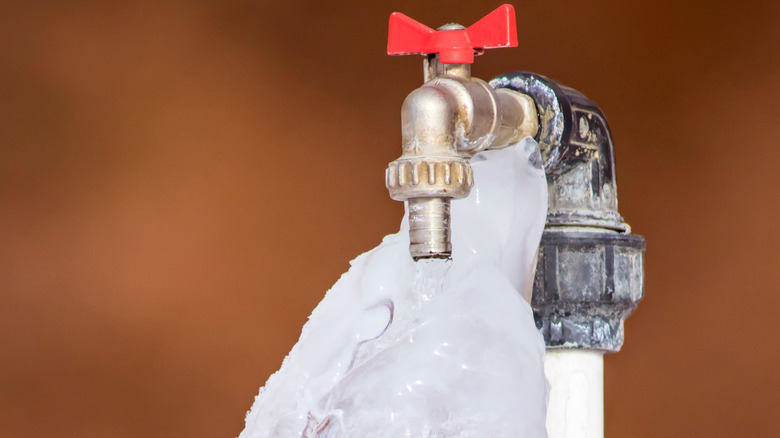Ways to Maintain Your Pipes from Freezing Damage: Crucial Advice
Ways to Maintain Your Pipes from Freezing Damage: Crucial Advice
Blog Article
Presented here in the next paragraphs you will find a good deal of sound content involving 6 Ways to Prevent Frozen Pipes.

Winter can ruin your plumbing, particularly by freezing pipes. Below's just how to avoid it from happening and what to do if it does.
Intro
As temperature levels drop, the threat of icy pipes rises, potentially resulting in pricey repair services and water damage. Recognizing how to stop frozen pipelines is important for homeowners in chilly environments.
Prevention Tips
Shielding vulnerable pipelines
Cover pipes in insulation sleeves or utilize warmth tape to safeguard them from freezing temperature levels. Concentrate on pipes in unheated or outside locations of the home.
Home heating strategies
Keep interior spaces sufficiently heated up, particularly areas with plumbing. Open up closet doors to enable warm air to circulate around pipelines under sinks.
Just how to determine frozen pipes
Seek decreased water circulation from faucets, unusual smells or sounds from pipelines, and noticeable frost on revealed pipelines.
Long-Term Solutions
Architectural adjustments
Think about rerouting pipes away from exterior wall surfaces or unheated locations. Include extra insulation to attic rooms, basements, and crawl spaces.
Updating insulation
Invest in premium insulation for pipelines, attic rooms, and wall surfaces. Correct insulation aids maintain constant temperature levels and decreases the danger of frozen pipes.
Shielding Outdoor Pipes
Yard hoses and outdoor taps
Separate and drain pipes yard pipes before wintertime. Set up frost-proof spigots or cover outdoor faucets with shielded caps.
Recognizing Frozen Pipes
What creates pipelines to freeze?
Pipes ice up when subjected to temperatures listed below 32 ° F (0 ° C) for extended durations. As water inside the pipes ices up, it expands, taxing the pipeline walls and possibly creating them to break.
Threats and damages
Frozen pipes can lead to supply of water interruptions, property damage, and pricey repairs. Ruptured pipelines can flood homes and trigger comprehensive architectural damage.
Indicators of Frozen Pipes
Determining icy pipes early can stop them from rupturing.
What to Do If Your Pipes Freeze
Immediate actions to take
If you suspect icy pipes, maintain faucets open to eliminate stress as the ice thaws. Utilize a hairdryer or towels taken in hot water to thaw pipelines gradually.
Final thought
Preventing frozen pipes calls for proactive procedures and quick feedbacks. By comprehending the reasons, indications, and safety nets, homeowners can safeguard their plumbing throughout cold weather.
Helpful Tips to Prevent Frozen Pipes this Winter
UNDERSTANDING THE BASICS: WHY PIPES FREEZE AND WHY IT’S A PROBLEM
Water freezing inside pipes is common during the winter months, but understanding why pipes freeze, and the potential problems it can cause is crucial in preventing such incidents. This section will delve into the basics of why pipes freeze and the associated problems that may arise.
THE SCIENCE BEHIND FROZEN PIPES
When water reaches freezing temperatures, it undergoes a physical transformation and solidifies into ice. This expansion of water as it freezes is the primary reason pipes can burst. As the water inside the pipe freezes, it expands, creating immense pressure on the walls. If the pressure becomes too great, the pipe can crack or rupture, leading to leaks and water damage.
FACTORS THAT CONTRIBUTE TO PIPE FREEZING
Low Temperatures: Extremely cold weather, especially below freezing, increases the risk of pipes freezing. Uninsulated or Poorly Insulated Pipes: Pipes located in unheated areas, such as basements, crawl spaces, or attics, are more prone to freezing. Insufficient insulation or lack of insulation altogether exacerbates the problem. Exterior Wall Exposure: Pipes running along exterior walls are susceptible to freezing as they encounter colder temperatures outside. Lack of Heating or Temperature Regulation: Inadequate heating or inconsistent temperature control in your home can contribute to frozen pipes. PROBLEMS CAUSED BY FROZEN PIPES
- Pipe Bursting: As mentioned earlier, the expansion of water as it freezes can cause pipes to burst, resulting in significant water damage.
- Water Damage: When pipes burst, it can lead to flooding and water damage to your property, including walls, ceilings, flooring, and personal belongings.
- Structural Damage: Prolonged exposure to water from burst pipes can compromise the structural integrity of your home, leading to costly repairs.
- Mold and Mildew Growth: Excess moisture from water damage can create a favorable environment for mold and mildew growth, posing health risks to occupants.
- Disrupted Water Supply: Frozen pipes can also result in a complete or partial loss of water supply until the issue is resolved.
WHY CERTAIN PIPES ARE MORE PRONE TO FREEZING
- Location: Pipes located in unheated or poorly insulated areas, such as basements, crawl spaces, attics, or exterior walls, are at higher risk of freezing.
- Exterior Pipes: Outdoor pipes, such as those used for irrigation or exposed plumbing, are particularly vulnerable to freezing as they are directly exposed to the elements.
- Supply Lines: Pipes that carry water from the main water supply into your home, including the main water line, are critical to protect as freezing in these lines can affect your entire plumbing system.
- Underground Pipes: Pipes buried underground, such as those connected to sprinkler systems or outdoor faucets, can be susceptible to freezing if not properly insulated.
https://busybusy.com/blog/helpful-tips-to-prevent-frozen-pipes-this-winter/

We hope you liked our excerpt about 6 Ways to Prevent Frozen Pipes. Thanks so much for taking a few minutes to read through our article. Sharing is caring. Helping others is fun. Thanks so much for taking the time to read it.
Schedule Now Report this page